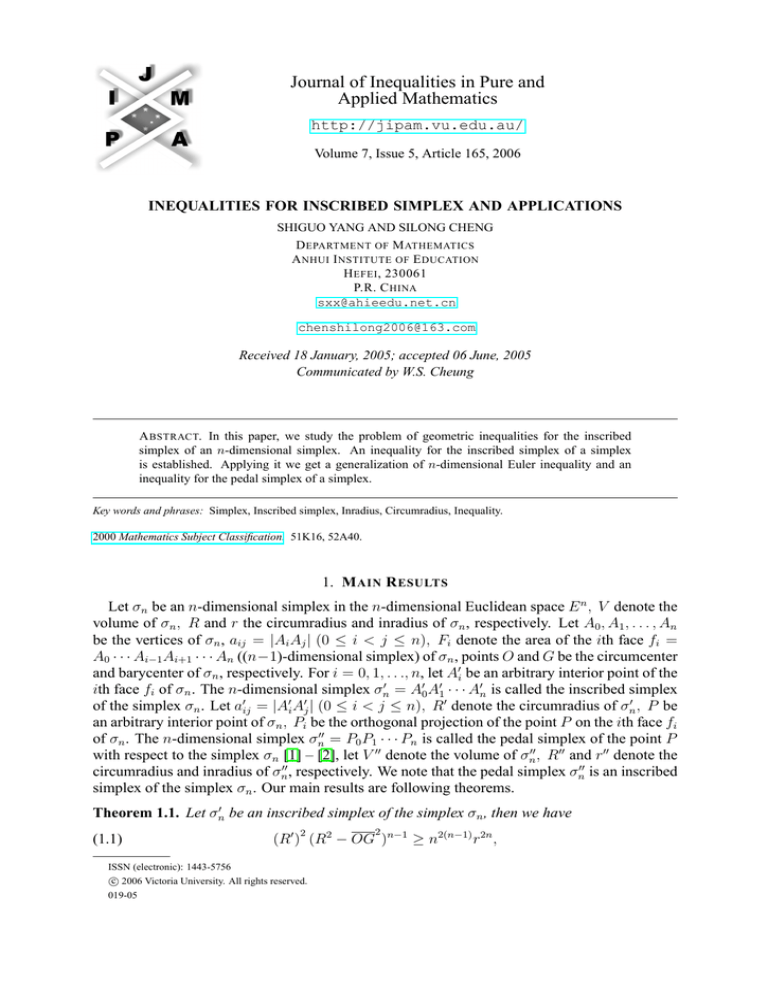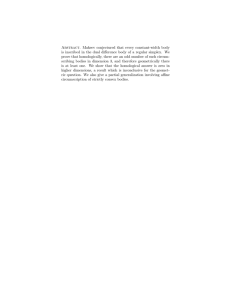
Journal of Inequalities in Pure and
Applied Mathematics
http://jipam.vu.edu.au/
Volume 7, Issue 5, Article 165, 2006
INEQUALITIES FOR INSCRIBED SIMPLEX AND APPLICATIONS
SHIGUO YANG AND SILONG CHENG
D EPARTMENT OF M ATHEMATICS
A NHUI I NSTITUTE OF E DUCATION
H EFEI , 230061
P.R. C HINA
sxx@ahieedu.net.cn
chenshilong2006@163.com
Received 18 January, 2005; accepted 06 June, 2005
Communicated by W.S. Cheung
A BSTRACT. In this paper, we study the problem of geometric inequalities for the inscribed
simplex of an n-dimensional simplex. An inequality for the inscribed simplex of a simplex
is established. Applying it we get a generalization of n-dimensional Euler inequality and an
inequality for the pedal simplex of a simplex.
Key words and phrases: Simplex, Inscribed simplex, Inradius, Circumradius, Inequality.
2000 Mathematics Subject Classification. 51K16, 52A40.
1. M AIN R ESULTS
Let σn be an n-dimensional simplex in the n-dimensional Euclidean space E n , V denote the
volume of σn , R and r the circumradius and inradius of σn , respectively. Let A0 , A1 , . . . , An
be the vertices of σn , aij = |Ai Aj | (0 ≤ i < j ≤ n), Fi denote the area of the ith face fi =
A0 · · · Ai−1 Ai+1 · · · An ((n−1)-dimensional simplex) of σn , points O and G be the circumcenter
and barycenter of σn , respectively. For i = 0, 1, . . ., n, let A0i be an arbitrary interior point of the
ith face fi of σn . The n-dimensional simplex σn0 = A00 A01 · · · A0n is called the inscribed simplex
of the simplex σn . Let a0ij = |A0i A0j | (0 ≤ i < j ≤ n), R0 denote the circumradius of σn0 , P be
an arbitrary interior point of σn , Pi be the orthogonal projection of the point P on the ith face fi
of σn . The n-dimensional simplex σn00 = P0 P1 · · · Pn is called the pedal simplex of the point P
with respect to the simplex σn [1] – [2], let V 00 denote the volume of σn00 , R00 and r00 denote the
circumradius and inradius of σn00 , respectively. We note that the pedal simplex σn00 is an inscribed
simplex of the simplex σn . Our main results are following theorems.
Theorem 1.1. Let σn0 be an inscribed simplex of the simplex σn , then we have
(1.1)
2
2
(R0 ) (R2 − OG )n−1 ≥ n2(n−1) r2n ,
ISSN (electronic): 1443-5756
c 2006 Victoria University. All rights reserved.
019-05
2
S HIGUO YANG
AND
S ILONG C HENG
with equality if the simplex σn is regular and σn0 is the tangent point simplex of σn .
Let Ti be the tangent point where the inscribed sphere of the simplex σn touches the ith face
fi of σn . The simplex σ n = T0 T1 · · · Tn is called the tangent point simplex of σn [3]. If we take
A0i ≡ Ti (i = 0, 1, . . ., n) in Theorem 1.1, then σn0 and σ n are the same and R0 = r, we get a
generalization of the n-dimensional Euler inequality [4] as follows.
Corollary 1.2. For an n-dimensional simplex σn , we have
2
R2 ≥ n2 r2 + OG ,
(1.2)
with equality if the simplex σn is regular.
Inequality (1.2) improves the n-dimensional Euler inequality [5] as follows.
R ≥ nr.
(1.3)
Theorem 1.3. Let P be an interior point of the simplex σn , and σn0 the pedal simplex of the
point P with respect to σn , then
n
R00 Rn−1 ≥ n2n−1 (r00 ) ,
(1.4)
with equality if the simplex σn is regular and σn00 is the tangent point simplex of σn .
2. S OME L EMMA AND P ROOFS OF T HEOREMS
To prove the theorems stated above, we need some lemmas as follows.
Lemma 2.1. Let σn0 be an inscribed simplex of the n-dimensional simplex σn , then we have
! n
!
X
X
2
(2.1)
Fi2 ≥ n2 (n + 1)V 2 ,
a0ij
i=0
0≤i<j≤n
with equality if the simplex σn is regular and σn0 is the tangent point simplex of σn .
Proof. Let B be an interior point of the simplex σn , and (λ0 , λ1 , . . ., λn ) the barycentric coordinates of the point B with respect to coordinate simplex σn . Here λi = P
Vi V −1 (i =
0, 1, . . ., n), Vi is the volume of the simplex σn (i) = BA0 · · · Ai−1 Ai+1 · · · An and ni=0 λi = 1.
Let Q be an arbitrary point in E n , then
n
−−→ X −−→
QB =
λi QAi .
i=0
From this we have
n
X
n
−−→ −
−−→ X −→
→
λi BAi =
λi QAi − QB = 0 ,
i=0
(2.2)
n
X
i=0
n
−−→2 X
−−→ −−→2
λi QAi =
λi QB + BAi
i=0
i=0
=
n
X
n
n
i=0
i=0
−−→
−−→ X −−→ X −−→2
λi QB 2 + 2QB ·
λi BAi +
λi BAi
i=0
−−→
= QB 2 +
n
X
−−→2
λi BAi .
i=0
J. Inequal. Pure and Appl. Math., 7(5) Art. 165, 2006
http://jipam.vu.edu.au/
I NEQUALITIES FOR I NSCRIBED S IMPLEX AND A PPLICATIONS
For j = 0, 1, . . ., n, taking Q ≡ Aj in (2.2) we get
n
n
−−−→2
−−→2
−−→2
X
X
λi λj Ai Aj = λj BAj + λj
(2.3)
λi BAi
i=0
3
(j = 0, 1, . . ., n).
i=0
Adding up these equalities in (2.3) and noting that
j=0
λj = 1, we get
n
−−−→2 X
−−→2
λ i λ j A i Aj =
λi BAi .
X
(2.4)
Pn
i=0
0≤i<j≤n
For any real numbers xi > 0 (i = 0, 1, . . ., n) and an inscribed simplex σn0 = A00 A01 · · · A0n of
σn , we take an interior point B 0 of σn0 such that (λ00 , λ01 , . . ., λ0n ) is.the barycentric coordinates
Pn
of the point B 0 with respect to coordinate simplex σn0 , here λ0i = xi
j=0 xj (i = 0, 1, . . ., n).
Using equality (2.4) we have
n
−−→2
X
X
0 0
0 2
λi λj aij =
λ0i B 0 A0i ,
i=0
0≤i<j≤n
i.e.
X
(2.5)
xi xj a0ij
2
=
n
X
!
n
X
xi
i=0
0≤i<j≤n
−−→2
xi B 0 A0i
!
.
i=0
Since B is an interior point of and is an inscribed simplex of σn , so B 0 is an interior point
of σn . Let the point Qi be the orthogonal projection of the point B 0 on the ith face fi of σn , then
0
σn0
σn0
n
X
(2.6)
n
−−→2
−−→2 X
0 0
xi B 0 Qi .
x i B Ai ≥
i=0
i=0
A0i
(i = 0, 1, . . ., n). In addition, we have
Equality in (2.6) holds if and only if Qi ≡
n X
→
−−
0
B
Q
(2.7)
i Fi = nV.
i=0
By the Cauchy’s inequality and (2.7) we have
! n
!
n
X
X
−−
→
2
(2.8)
xi B 0 Qi 2
x−1
≥
i Fi
i=0
i=0
n X
→
−−
B 0 Qi · Fi
!2
= (nV )2 .
i=0
Using (2.5), (2.6) and (2.8), we get
!
(2.9)
X
xi xj a0ij
2
0≤i<j≤n
n
X
!
x−1 Fi2
≥ n2
n
X
!
xi V 2 .
i=0
i=0
Taking x0 = x1 = · · · = xn = 1 in (2.9), we get inequality (2.1). It is easy to prove that equality
in (2.1) holds if the simplex σn is regular and σn0 is the tangent point simplex of σn .
Lemma 2.2 ([1, 6]). For the n-dimensional simplex σn , we have
(2.10)
n
X
!
Fi2 ≤ [nn−4 (n!)2 (n + 1)n−2 ]−1
i=0
X
a2ij
,
0≤i<j≤n
with equality if the simplex σn is regular.
J. Inequal. Pure and Appl. Math., 7(5) Art. 165, 2006
http://jipam.vu.edu.au/
4
S HIGUO YANG
AND
S ILONG C HENG
Lemma 2.3 ([2]). Let P be an interior point of the simplex σ, σn00 the pedal simplex of the point
P with respect to σn , then
V ≥ nn V 00 ,
(2.11)
with equality if the simplex σn is regular.
Lemma 2.4 ([1]). For the n-dimensional simplex σn , we have
nn/2 (n + 1)(n+1)/2 n
r ,
n!
with equality if the simplex σn is regular.
V ≥
(2.12)
Lemma 2.5 ([4]). For the n-dimensional simplex σn , we have
X
2
2
2
2
(2.13)
aij = (n + 1) R − OG .
0≤i<j≤n
Here O and G are the circumcenter and barycenter of the simplex σn , respectively.
Proof of Theorem 1.1. Using inequalities (2.1) and (2.10), we get
!
!n−1
X
X
2
(2.14)
a0ij
a2ij
≥ nn−2 (n!)2 (n + 1)n−1 V 2 .
0≤i<j≤n
0≤i<j≤n
By Lemma 2.5 we have
(2.15)
X
a0ij
2
2
≤ (n + 1)2 (R0 ) .
0≤i<j≤n
From (2.13), (2.14) and (2.15) we get
nn−1 (n!)2 2
2 n−1
2
≥
V .
(2.16)
(R0 ) R2 − OG
(n + 1)n+1
Using inequalities (2.16) and (2.12), we get inequality (1.1). It is easy to prove that equality in
(1.1) holds if the simplex σn is regular and σn0 is the tangent point simplex of σn .
Proof of Theorem 1.3. Since the pedal simplex σn00 is an inscribed simplex of the simplex σn ,
thus inequality (2.16) holds for the pedal simplex σn00 , i.e.
nn−2 (n!)2 2
2 n−1
00 2
2
(2.17)
(R ) R − OG
≥
V .
(n + 1)n+1
Using inequalities (2.17) and (2.11), we get
n3n−2 (n!)2
2 n−1
2
2
2
(2.18)
(R00 ) R2(n−1) ≥ (R00 ) R2 − OG
≥
(V 00 )
(n + 1)n+1
By Lemma 2.4 we have
nn/2 (n + 1)(n+1)/2 00 n
(r ) .
n!
From (2.18) and (2.19) we obtain inequality (1.4). It is easy to prove that equality in (1.4) holds
if the simplex σn is regular and σn00 is the tangent point simplex of σn .
(2.19)
V 00 ≥
J. Inequal. Pure and Appl. Math., 7(5) Art. 165, 2006
http://jipam.vu.edu.au/
I NEQUALITIES FOR I NSCRIBED S IMPLEX AND A PPLICATIONS
5
R EFERENCES
[1] D.S. MITRINOVIĆ, J.E. PEČARIĆ AND V. VOLENEC, Recent Advances in Geometric Inequalities, Kluwer Acad. Publ., Dordrecht, Boston, London, 1989, 425–552.
[2] Y. ZHANG, A conjecture on the pedal simplex, J. of Sys. Sci. Math. Sci., 12(4) (1992), 371–375.
[3] G.S. LENG, Some inequalities involving two simplexes, Geom. Dedicata, 66 (1997), 89–98.
[4] Sh.-G. YANG AND J. WANG, Improvements of n-dimensional Euler inequality, J. Geom., 51 (1994),
190–195.
[5] M.S. KLAMKIN, Inequality for a simplex, SIAM. Rev., 27(4) (1985), 576.
[6] L. YANG AND J.Zh. ZHANG, A class of geometric inequalities on a finite number of points, Acta
Math. Sinica, 23(5) (1980), 740–749.
J. Inequal. Pure and Appl. Math., 7(5) Art. 165, 2006
http://jipam.vu.edu.au/








